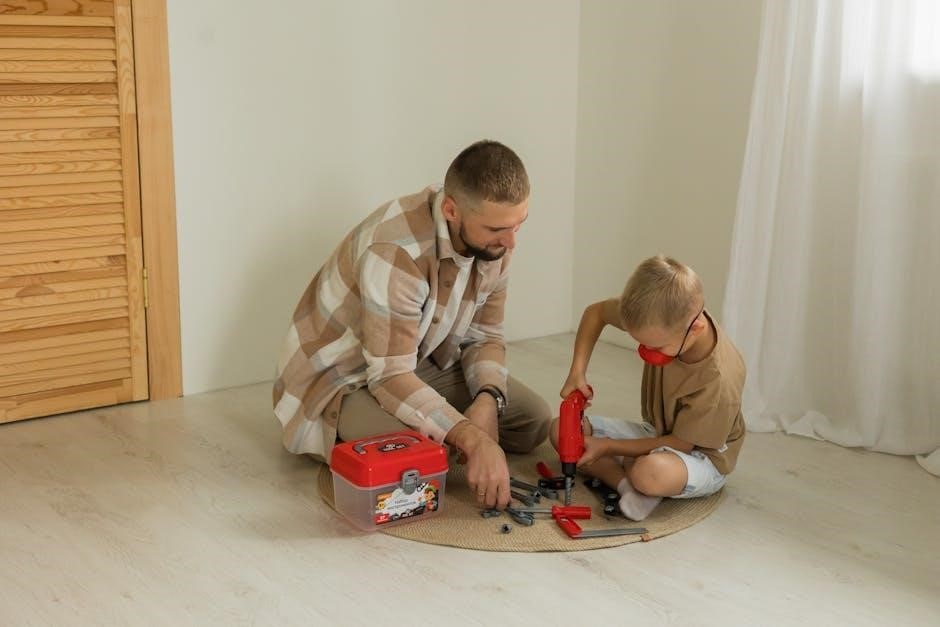A shortboard size guide helps surfers choose the right board for optimal performance and maneuverability. Understanding the correct dimensions ensures a better surfing experience‚ tailored to individual needs and skill levels‚ making it essential for all surfers to find the perfect fit.
1.1 Overview of Shortboard Size Guide
A shortboard size guide provides a comprehensive framework for selecting the ideal surfboard dimensions. It helps surfers understand how board length‚ width‚ and thickness impact performance. By considering factors like skill level‚ weight‚ and wave conditions‚ the guide ensures a tailored fit. This tool is essential for both beginners and advanced riders‚ offering insights into how different sizes affect maneuverability and stability. Whether you’re chasing speed or control‚ the guide simplifies the selection process‚ helping you find the perfect board to enhance your surfing experience. It’s a must-have resource for anyone looking to optimize their time in the water.
1.2 Importance of Choosing the Right Shortboard Size
Choosing the right shortboard size is crucial for optimal performance and enjoyment in surfing. A board that is too small may lack stability‚ while one that is too large can be difficult to maneuver. Proper sizing ensures better control‚ making it easier to catch waves and perform tricks. It also enhances your ability to balance and pivot‚ which are key for progressing in the sport. Selecting the right size tailored to your height‚ weight‚ and skill level ensures a more enjoyable and productive surfing experience. This customization is vital for maximizing your potential in the water.

Understanding How to Choose the Right Shortboard Size
Selecting the right shortboard size involves balancing factors like height‚ weight‚ skill level‚ and wave conditions. A properly sized board enhances control and maneuverability‚ ensuring an optimal surfing experience.
2.1 Factors Influencing Shortboard Size Selection
Several key factors influence shortboard size selection‚ including rider height‚ weight‚ skill level‚ and wave conditions. A surfer’s height and weight determine the necessary volume for buoyancy‚ while skill level affects maneuverability preferences. Wave conditions‚ such as wave size and strength‚ also play a role in choosing the appropriate board dimensions. Personal preference for performance‚ stability‚ or speed further tailors the selection process. Understanding these factors helps surfers find a board that matches their needs and enhances their overall surfing experience.
2.2 How Rider Height and Weight Affect Shortboard Size
Rider height and weight significantly impact shortboard size selection. A taller surfer may prefer a slightly longer board for better control‚ while shorter surfers can manage shorter boards more easily. Weight plays a crucial role in determining the board’s volume‚ as heavier surfers require more buoyancy to stay afloat. Lighter surfers can opt for a board with less volume‚ allowing for quicker turns and improved maneuverability. Balancing height and weight ensures the board’s performance aligns with the rider’s physical characteristics‚ enhancing their surfing experience.
2.3 Role of Skill Level in Determining Shortboard Size
A surfer’s skill level plays a key role in selecting the right shortboard size. Beginners benefit from larger‚ more buoyant boards for stability and ease of catching waves. Intermediate surfers can transition to slightly smaller boards‚ balancing maneuverability and float. Advanced riders often prefer shorter‚ narrower boards for precise control and performance in challenging conditions. Skill level directly influences the board’s volume‚ length‚ and width‚ ensuring it matches the surfer’s ability to paddle‚ balance‚ and maneuver effectively in the water.
2.4 Impact of Wave Conditions on Shortboard Size
Wave conditions significantly influence the choice of shortboard size. In small waves‚ a board with more volume and a fuller shape is ideal for easier paddling and wave catching. For medium waves‚ a balanced shortboard size works well‚ offering stability and maneuverability. In heavy or large waves‚ shorter and narrower boards are preferred‚ as they provide better control and quicker turns. Wave type‚ such as beach breaks or reef breaks‚ also affects the decision‚ with reef waves often requiring more precise board dimensions for performance.

Shortboard Volume and Its Significance
Shortboard volume determines buoyancy and stability‚ impacting how the board performs in the water. Proper volume ensures the board floats and maneuvers effectively for riders of all levels.
3.1 What is Shortboard Volume?
Shortboard volume refers to the total amount of space the board displaces in the water‚ measured in liters. It is calculated based on the board’s length‚ width‚ and thickness. Higher volume means more buoyancy‚ making it easier to catch waves‚ while lower volume allows for better maneuverability. Volume is crucial for performance‚ as it directly impacts how the board interacts with the water. Proper volume ensures the board floats and responds optimally for the rider’s weight and skill level‚ making it a key factor in selecting the right shortboard for specific surfing conditions and preferences.
3.2 How to Measure Shortboard Volume
Measuring shortboard volume involves calculating the board’s displacement in water‚ typically expressed in liters. The volume is derived from the board’s length‚ width‚ and thickness. To calculate‚ multiply these dimensions together (Length × Width × Thickness) and multiply by the material’s density. For example‚ a shortboard with dimensions 6’0″ × 18.5″ × 2.25″ and a foam density of 1.0 would have a volume of approximately 24.5 liters. Manufacturers often use digital scanners for precise measurements‚ while manual calculations remain common. Understanding volume helps surfers match their weight and skill level to the board’s buoyancy and performance.

3.3 Volume Recommendations Based on Surfer’s Skill Level
Volume recommendations for shortboards vary based on the surfer’s skill level. Beginners typically benefit from higher volume boards (25-30 liters) for better buoyancy and stability. Intermediate surfers can opt for moderate volumes (20-25 liters)‚ balancing ease of riding with improved maneuverability. Advanced surfers often prefer lower volumes (15-20 liters) for enhanced performance and agility in challenging conditions. Matching the surfer’s skill level with the appropriate volume ensures optimal performance‚ making it easier to catch waves and execute turns effectively.

Shortboard Width and Thickness

Shortboard width and thickness significantly impact performance. Wider boards offer stability‚ while thicker ones provide buoyancy. The right combination enhances control and maneuverability for all surfers.
4.1 Standard Width Ranges for Shortboards
Shortboards typically range in width from 18 to 20 inches‚ with the width measured at the board’s widest point. This narrower width enhances maneuverability and speed‚ ideal for experienced surfers seeking performance in various wave conditions. The standard width supports a balance between stability and agility‚ catering to a broad range of surfer preferences and wave types.

4.2 Standard Thickness Ranges for Shortboards
Shortboards generally range in thickness from 2 to 3 inches‚ with the thickness measured from the top to the bottom of the board. Thicker boards (closer to 3 inches) provide more buoyancy and stability‚ making them suitable for smaller or less experienced surfers. Thinner boards (around 2 inches) are lighter and more responsive‚ ideal for advanced surfers seeking high-performance maneuverability. The thickness directly impacts the board’s floatation and sensitivity‚ making it a critical factor in balancing speed and control for different surfing styles and wave conditions.
4.3 How Width and Thickness Affect Performance
The width and thickness of a shortboard significantly influence its performance. A wider board provides more stability and flotation‚ making it easier to catch waves‚ especially for beginners or in smaller conditions. Narrower boards‚ while less stable‚ allow for tighter turns and better maneuverability. Thickness affects buoyancy and sensitivity; thicker boards float better but may feel less responsive‚ while thinner boards are more agile but require more skill to manage. Balancing these dimensions ensures the board suits the surfer’s style‚ wave preferences‚ and skill level‚ optimizing both speed and control in the water.
Shortboard Size for Different Skill Levels
- Beginners: Longer‚ wider boards (7’–7’6″) for stability and ease.
- Intermediate: Balanced sizes (6’8″–7’2″) for progressing skills.
- Advanced: Shorter‚ narrower boards (6’–6’6″) for precision and speed.
5.1 Shortboard Size for Beginners
For beginners‚ a shortboard size that prioritizes stability and buoyancy is essential. A longer and wider board makes it easier to catch waves and stay balanced. Typically‚ boards ranging from 7′ to 7’6″ in length and 21″ to 22″ in width are recommended. This size range provides enough volume for buoyancy while maintaining maneuverability. Thicker boards (around 2.75″) are also beneficial for beginners‚ as they offer more floatation and forgiveness. Choosing the right size helps build confidence and improves the learning curve for new surfers. Always consider your height‚ weight‚ and the types of waves you’ll be surfing when selecting your board.
5.2 Shortboard Size for Intermediate Surfers
For intermediate surfers‚ shortboard size should balance performance and control. Boards typically range from 6’6″ to 7’0″ in length and 20″ to 21″ in width. This size allows for easier maneuverability while maintaining stability. Thickness usually falls between 2.5″ to 2.7″‚ providing a responsive feel without sacrificing buoyancy. Intermediate surfers can handle slightly less volume‚ enabling sharper turns and better speed. The right size depends on the surfer’s height‚ weight‚ and wave preferences. A well-suited board enhances progression and confidence in the water. Adjustments in size may be needed as skills improve and wave conditions vary.
5.3 Shortboard Size for Advanced Surfers
Advanced surfers typically prefer shorter‚ more maneuverable boards‚ ranging from 6’2″ to 6’10” in length. Width generally falls between 19″ and 20.5″‚ with thickness around 2.3″ to 2.6″. These dimensions allow for quick turns and high-speed performance. The ideal size depends on the surfer’s height‚ weight‚ and wave preferences. Lower volume boards are favored for precision‚ but ensuring enough floatation is crucial. Advanced surfers often tailor their shortboard size to specific wave conditions‚ seeking optimal control and responsiveness. Personal preference plays a significant role in refining the perfect board for their skill level.

Shortboard Size and Wave Conditions
Shortboard size adapts to wave conditions‚ with smaller boards (6’6″-7’0″) for heavy waves and slightly larger ones (7’0″-7’6″) for smaller waves‚ balancing performance and control.
6.1 Shortboard Size for Small Waves
For small waves‚ a shortboard size of 7’0″ to 7’6″ is ideal‚ offering enough volume to generate speed and stability. These boards typically have a rounded nose shape‚ which enhances buoyancy and makes it easier to catch smaller waves. A slightly longer length ensures better paddle power‚ while maintaining maneuverability. Intermediate to advanced surfers may opt for slightly shorter boards (6’8″-7’2″) for tighter turns‚ but beginners should stick to the higher end of this range for stability. The key is balancing floatation and responsiveness to handle the challenges of smaller wave conditions effectively.
6.2 Shortboard Size for Medium Waves
For medium waves‚ a shortboard size of 6’6″ to 7’2″ is recommended‚ offering a balance between performance and ease of use. This range suits most surfers‚ providing enough volume to maintain speed while remaining maneuverable. Intermediate surfers often prefer boards around 6’10” for all-around performance. Advanced riders may opt for slightly shorter boards (6’6″-6’8″) for tighter turns. The volume should be moderate‚ around 34-40 liters‚ depending on the surfer’s weight and skill level. Boards with a rounded nose and performance rails are ideal for medium waves‚ combining stability and responsiveness.
6.3 Shortboard Size for Heavy Waves
For heavy waves‚ a shortboard size of 7’0″ to 7’6″ is ideal‚ offering stability and control in powerful conditions. These boards typically have more volume (38-45 liters) to maintain speed and buoyancy. A slightly thicker profile (2.5″-2.75″) and wider nose provide better paddling power and wave-catching ability. Advanced riders may prefer shorter lengths (7’0″-7’2″) for precision‚ while heavier surfers benefit from added volume. Narrower outlines and rounded pins enhance hold and direction in steep‚ fast waves. This size range balances performance and manageability in challenging‚ heavy wave environments.

Using Brand-Specific Shortboard Size Charts
Brand-specific charts provide tailored recommendations based on height‚ weight‚ and skill level. They often include volume ranges and dimensions optimized for their board models‚ ensuring a precise fit.
7.1 How to Interpret Brand-Specific Size Charts
Brand-specific size charts are tailored to each manufacturer’s designs‚ considering factors like height‚ weight‚ skill level‚ and wave conditions. They typically include detailed volume‚ length‚ and width recommendations. To interpret them‚ start by identifying your height and weight range. Match these to the corresponding shortboard dimensions. Pay attention to skill-level categories‚ as brands often categorize boards for beginners‚ intermediates‚ or advanced riders. Wave conditions may also influence recommendations. Compare multiple charts to understand variations between brands‚ as some may prioritize maneuverability over stability. Always cross-reference with your surfing style and preferences for the best fit.
7.2 Popular Brands and Their Size Recommendations
Popular surfboard brands like Channel Islands‚ Firewire‚ and JS Industries provide detailed size charts tailored to their models. These charts often include volume‚ length‚ and width recommendations based on rider height‚ weight‚ and skill level. For example‚ Channel Islands’ charts cater to performance-driven boards‚ while Firewire focuses on volume-based sizing for stability. JS Industries offers size guides that prioritize maneuverability and wave performance. Each brand may vary slightly‚ so comparing their recommendations can help you find the best fit for your surfing style and preferences. Always check the specific model details for accurate sizing.

Final Considerations for Choosing a Shortboard
When selecting a shortboard‚ prioritize balancing performance and maneuverability while ensuring personal fit and comfort. Test ride options and seek expert advice to make an informed decision.
8.1 Balancing Performance and Maneuverability
Balancing performance and maneuverability is crucial when selecting a shortboard. A board with too much volume may compromise sensitivity‚ while too little can reduce stability. Shorter lengths enhance agility but may sacrifice speed‚ whereas longer boards offer better momentum but are less responsive. The rocker and fin setup also play a significant role‚ as they affect both stability and turning ability. Surfers must weigh their need for speed versus control based on skill level and wave conditions. This balance ensures optimal performance‚ making the board both functional and enjoyable to ride in various surfing scenarios.
8.2 Personal Preference and Fit
Personal preference and fit play a vital role in selecting the right shortboard. While size charts provide a starting point‚ individual comfort and style cannot be overlooked. Surfers may prefer boards that align with their stance‚ flexibility‚ and overall surfing approach. The board’s length‚ width‚ and thickness should complement the rider’s height‚ weight‚ and balance. Additionally‚ personal preference often influences choices like the board’s shape‚ concave‚ and even color‚ ensuring a connection between the surfer and their equipment. Ultimately‚ the best fit is one that feels natural and enhances the surfing experience‚ blending functionality with personal satisfaction.
Selecting the right shortboard size is crucial for optimal performance. Consider skill level‚ wave conditions‚ volume‚ and personal fit. Balance these factors to enhance your surfing experience.
9.1 Summary of Key Points
9.2 Final Tips for Selecting the Right Shortboard
When finalizing your shortboard choice‚ balance performance and buoyancy based on your skill level and surfing style. Always test a board in real conditions if possible‚ as feel and responsiveness can vary. Consider consulting with experienced surfers or shop experts for personalized advice. Trust your instincts and prioritize a board that feels right to you. Remember‚ the perfect shortboard is one that enhances your surfing experience while allowing you to progress and enjoy the water. Patience and research will lead to the best decision for your next surf adventure.



